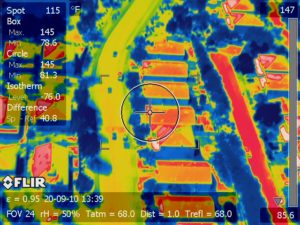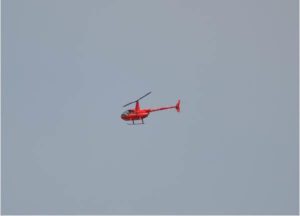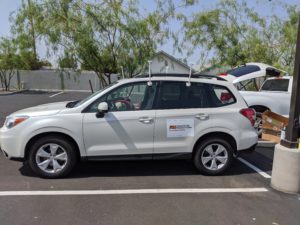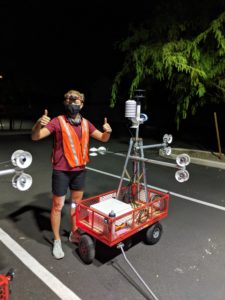We are excited to announce the 3rd annual Urban Climate Research Center Poster Event. This year’s event includes posters from 8 ASU schools and collaborators at 4 other universities. As it will be online, we REQUIRE participants to RSVP in advance so that we can send you the zoom links and password to attend this unique event, which will include parallel poster room sessions so that each individual poster presenter will be able to directly interact with interested event participants.
Urban Climate News
UCRC Exploring Cool Pavements in Phoenix
This summer the City of Phoenix has been experimenting with a cool-seal product that replaces the traditional very dark seal coat that is applied to streets every 3-5 years with a more solar-reflective coating that holds promise for cooling the city. ASU’s Urban Climate Research Center has been partnering with the city to evaluate the thermal effects in neighborhoods where the technology has been deployed. We have conducted 3 intensive monitoring campaigns this summer using cart-based (MaRTy Cart) mean radiant temperature measurements, car-based air and surface temperature traverse measurements, and helicopter-based thermography. We are also tracking subsurface temperature and pavement thermal storage as well as the evolution of the seal-coat radiative properties. With much of the data now in hand, we turn to the task of analyzing the results. Thanks to the many students and faculty who gave up sleep (measurements starting at 4am) and sweat (peak temps > 110F) to make this happen!
The motley drivers of heat and cold exposure in 21st century US cities
Ashley Broadbent, an Assistant Research Professor in Geographical Sciences and Urban Planning, and faculty affiliate of the Urban Climate Research Center, together with colleagues Scott Krayenhoff and Matei Georgescu, has recently published “The motley drivers of heat and cold exposure in 21st century US cities” in the Proceedings of the National Academy of Sciences (PNAS). The paper presents population-weighted estimates of outdoor heat and cold exposure, considering both global climate change and urban expansion during the 21st century. The results are particularly significant for cities in the US sunbelt, which are projected to see the greatest increase in population over the next several decades. This work represents an important contribution to understanding future heat/cold exposure, particularly when linked with other recent studies exploring indoor vs. outdoor exposure and relative access to shaded outdoor or air-conditioned indoor environments.
The full paper can be found here.
New opportunities for graduate students in the UCRC!
It is not uncommon for projects to be funded out of sync with the normal graduate student recruitment and application processes. In fact, we have several projects that have recently been funded, and several that may be funded in the next several months. We anticipate being able to bring students in for new projects on a fast-track process for Fall 2020 or for Spring 2021.
One such opportunity follows:
UCRC Faculty Affiliate Awarded Prestigious CAREER Grant
UCRC Faculty Affiliate, Dr. Ariane Middel, Assistant Professor of the School of Arts, Media and Engineering, Herberger Institute for Design and the Arts, has been awarded an NSF Career Award for the project: Human Thermal Exposure in Cities – Novel Sensing and Modeling to Build Heat-Resilience.
Human thermal exposure to extreme heat is a growing health concern and pressing societal problem worldwide that will be exacerbated by climate variability, more frequent and intense heat waves, continued urbanization, and socio-demographic changes towards bigger economic disparities and a growing elderly population. The goal of this Faculty Early Career Development (CAREER) grant is to advance understanding of how the built environment impacts heat and human thermal exposure in cities. Bridging the gap between localized field-based work and large-scale, generalizable models, this transformative project will expand beyond the limits of conventional heat research and fundamentally reframe how heat is assessed in urban areas by using radiation-based metrics and indices. New academic-practitioner partnerships with cities will yield co-developed, solutions-oriented research that translates into actionable best practices for infrastructure management and human-centric heat hazard mitigation. This work aligns with NSF’s mission to advance public health and well-being. It has the potential to result in broader societal change by informing public policy to make communities more thermally comfortable and walkable, increase heat awareness, build adaptive capacity and community resilience to heat, and potentially reduce the incidence of heat-related illness and death.
The Faculty Early Career Development (CAREER) Program is a prestigious Foundation-wide activity that offers the National Science Foundation’s most prestigious awards in support of early-career faculty who have the potential to serve as academic role 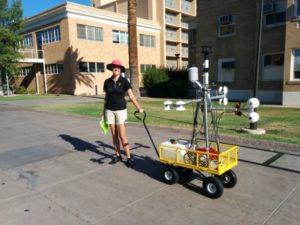 models in research and education and to lead advances in the mission of their department or organization. Activities pursued by early-career faculty should build a firm foundation for a lifetime of leadership in integrating education and research.
models in research and education and to lead advances in the mission of their department or organization. Activities pursued by early-career faculty should build a firm foundation for a lifetime of leadership in integrating education and research.
Urban Climate Session at European Geophysical Union
Please consider submitting an abstract to the following session:
European Geophysical Union (EGU) general assembly, 3-8 May 2020:
CL2.5: Urban climate, urban biometeorology, and science tools for cities
Organized by: Matei Georgescu, Sorin Cheval, Matthias Demuzere, Natalie Theeuwes, and Hendrik Wouters
As the most evident example of land use and land cover change, urban areas play a fundamental role in local to large-scale planetary processes, via modification of heat, moisture, and chemical budgets. With rapid urbanization ramping up globally it is essential to recognize the consequences of landscape conversion to the built environment. Given the capability of cities to serve as first responders to global change, considerable efforts are currently being dedicated across many cities to monitor and understand urban atmospheric dynamics and examine various adaptation and mitigation strategies aimed to offset impacts of rapidly expanding urban environments and influences of large-scale greenhouse gas emissions.
This session solicits submissions from both the observational and modelling communities examining urban atmospheric and landscape dynamics, processes and impacts owing to urban induced climate change, the efficacy of various strategies to reduce such impacts, and techniques highlighting how cities are already using novel science data and products that facilitate planning and policies on urban adaptation to and mitigation of the effects of climate change. Emerging topics including, but not limited to, urban climate informatics, are highly encouraged.
https://meetingorganizer.copernicus.org/EGU2020/session/36740
The CL2.5 Session Solicited/Invited Talk will be given by Prof. Tony Brazel, recipient of the International Association of Urban Climate’s Luke Howard Award, the American Meteorological Society’s Helmut E. Landsberg Award, Lifetime Achievement Award of the Association of American Geographers’ Climate Specialty Group, and the Jeffrey Cook Prize in Desert Architecture from Ben-Gurion University of the Negev, Israel.
The abstract submission and early registration deadlines are:
Abstract Submission – deadline: 15 January 2020, 13:00 CET
https://egu2020.eu/abstracts_and_programme/how_to_submit_an_abstract.html
Early Registration – deadline: 31 March 2020
https://egu2020.eu/register_and_venue/registration.html
2nd Annual Anthony J. Brazel Urban Climate Lecture Series
We are excited to welcome Dr. Dev Niyogi of Purdue University as the 2nd speaker in this annual series of urban climate lectures.
The lecture will be held Thursday Nov. 7, 5:30 – 7 pm in the Alumni Room (#202) of the ASU Memorial Union. There will be a reception from 5- 5:30 pm
RSVP: ucrclecture.eventbrite.com
How gaming and simulation can inform the design of future climate-resilient cities
Abstract:
Cities and urban-sprawl is a global phenomenon. Because cities have concentrated population, emissions, and infrastructure development, they tend to be warmer than the surrounding areas. In addition to the urban heating, cities also alter regional climate by changing rainfall patterns, and winds. Cities in turn, are also increasingly vulnerable to climatic extremes such as heavy rains, floods, and heatwaves. Efforts are ongoing in the researcher and practitioner communities to improve prediction of high impact events over urban areas, and help cities become more resilient to climatic changes. This talk will discuss examples of integrating emerging technologies such as from video gaming and machine learning into weather and climate studies. These augmented technology tools within weather models can help improve urban-scale weather forecasting. They also promote better understanding of how cities impact climate. This information can be used to predict and mitigate some of the harmful effects of urbanization and changing climate, such as heatwaves and flooding. Examples of how urban climate science is being used to help develop tools and a network for resilient and livable cities will also be presented.
Speaker Bio:
Dev Niyogi is the Chair of the American Meteorological Society’s (AMS) Board of Urban Environment and advisory board member of the International Association of Urban Climate. He was also a co-convenor of the 10th International Conference on Urban Climate, held in New York City, 2018. He is currently on the boards of several key journals in his field, including: Urban Climate, Climate Research, Journal of Applied Climatology and Meteorology, and Remote Sensing. Dr. Niyogi also serves as a volume editor for the Elsevier/Academic Press Major Reference Work on Climate Vulnerability. He has published over 190 international papers, and according to Google Scholar, his research has been cited over 11,000 times (h-index>50). His work has been highlighted in numerous media outlets, including such popular press as Wired, CNN, National Georgaphic, and TedxTalks.
Global KAITEKI Center Launch at ASU
The Global KAITEKI Center at ASU will hold a special launch event Thursday, October 24, 2019. This Center represents a landmark partnership between Mitsubishi Chemical Holding Corporation (MCHC), its think-tank the KAITEKI Institute (TKI), and ASU. TKI focuses on the “sustainable well-being of people, society and our plant Earth”. It is an original concept of MCHC that proposes a sustainable path forward, serving as a guide for solving environmental and social issues. For more background on the Center see the initial announcement.
One thrust within the Center focuses on urban cooling. Charles L. Redman (School of Sustainability) leads the Design, Development, and Testing of Innovative Materials for Urban Cooling Project. Team members include: Matthew Fraser (School of Sustainable Engineering and the Built Environment), David Sailor (School of Geographical Sciences and Urban Planning), and Kamil Kaloush (School of Sustainable Engineering and the Built Environment).
Considering the anticipated warming of the world’s cities and the associated impacts on health and well-being, the Urban Cooling project will contribute significantly to sustainable urban development by focusing on the important role of urban infrastructure on urban heat; in Phoenix, more than 50% of the urban surface area is urban infrastructure (building rooftops 18%; roads, 14%; sidewalks, 3%; parking areas, 15%. The purpose of this collaboration is to advance mitigation of urban heat along three related threads: (1) Modeling impact of alternative roof surface coatings and paving technologies; (2) Development of novel asphalt pavement binders to integrate improved thermal and reflective properties; and (3) Field demonstration of mitigation approaches.
Dr. Kamil Kaloush and Dr. David Sailor lead two major directions of this project. While Dr. Kaloush will investigate the use of alternate materials for roadways and pavements, Dr. Sailor will use modeling techniques to explore new building materials as options to mitigate heat.
Specifically, Kaloush and his team will investigate the use of silica gel, trimethylsilylated (aerogel) and /or phase changing materials (PCMs) in asphalt binder modifications. The use of PCMs in asphalt binders and/or mixtures is promising and expected to mitigate problems related to rutting and thermal cracking.
Sailor and his group will analyze the role of building construction materials including passive daytime radiative cooling (PDRC) roofing materials for improving urban thermal environments and reducing building energy consumption. This study will integrate models from building to city scales, to quantify effects and develop an assessment of the market by exploring tradeoffs between desired cooling in summer and less desirable cooling in winter.
Over the 3-year project period, the work of these teams will be integrated and incorporated into a comprehensive analysis of how the combination of innovations in building and paving materials may be able to cool global hot climate cities.
UCRC Student to Represent ASU at COP-25
ASU has released the names of its delegation to the United Nations Framework Convention on Climate Change. The delegation includes nine students–5 from the Sandra Day O’Connor College of Law, 3 from the School of Sustainability (SOS), and 1 from the School of Geographical Sciences and Urban Planning (SGSUP). The UCRC is proud to announce that Ph.D. candidate, Peter Crank will be representing SGSUP as part of this delegation. This group will be attending the Council of Parties (COP) meeting in Santiago, Chile, December 2-13, 2019.
Peter will be participating in the first week of activities, with the Subsidiary Body for Scientific and Technological Advice. When asked what his goal was for the meeting, Peter replied, “to provide insights into urban climate mitigation and adaptation strategies that can shape the advice coming from the scientific and technological communities.” This subcommittee serves as a key liaison to the policymakers that define the larger conference’s aim and scope.
The Conference of the Parties (COP) is The United Nations Framework Convention on Climate Change (UNFCCC) providing an international response to climate change. COP is a yearly conference from which the 1998 Kyoto Protocol and the 2016 Paris Climate Agreement were developed.
This is a tremendous opportunity for these ASU students to have an active role in today’s decision making global policies. Peter wanted readers to know that he Is “humbled, honored, and thrilled to be appointed as a delegate from the university and is looking forward to the opportunity to engage in a process that has been defining global politics on climate change for the past 25 years.”
Presentation: Professor Francisco Salamanca Palou at the MPAS/WRF Workshop
Francisco Salamanca Palou, Assistant Research Professor, School of Mathematical and Statistical Sciences, June 10, 2019, presented “Summer and Wintertime Variations of the Surface and Near-surface UHI in a Semiarid Environment” to a joint MPAS/WRF workshop. Prepared by both Salamanca & colleague Alex Mahalov, Dean’s Distinguished Professor from the same school, Salamanca explained the motivation for this work stems from recent work done to augment the WRF-urban modeling system. Realizing that there was still additional work to complete, Salamanca and Mahalov set out to “examine summer- and wintertime variations of the surface and near-surface UHI for a semiarid urban environment using MODIS and near-surface meteorological observations.” Also, “to evaluate the WRF-urban modeling system’s (coupled to Noah-MP LSM) ability to reproduce the diurnal cycle of near-surface meteorology and LST during 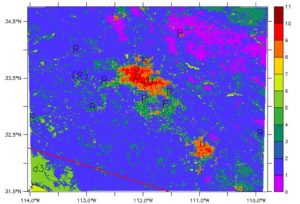 both summer and wintertime weather conditions.”
both summer and wintertime weather conditions.”
Sharing detailed modeling experiments, the author’s conclusions were:
- The Surface UHI is found to be higher at night and during the warm season.
- The morning Surface UHI is low and frequently exhibits an Urban Cool Island that increases during the summertime period.
- The Near-surface UHI is higher at night and during summertime.
- The morning Near-surface UHI is low but rarely exhibits an Urban Cool Island.
- WRF (coupled to Noah-MP) model tends to slightly underestimate surface skin temperature during daytime but overestimates nighttime values during wintertime.
- WRF (coupled to Noah-MP) model tends to accurately reproduce the diurnal cycle of near-surface air temperature and wind speed during summertime, but overestimate near-surface nighttime air temperature during wintertime.
The entire presentation is available at: http://www2.mmm.ucar.edu/wrf/users/workshops/WS2019/workshop19agenda.php


